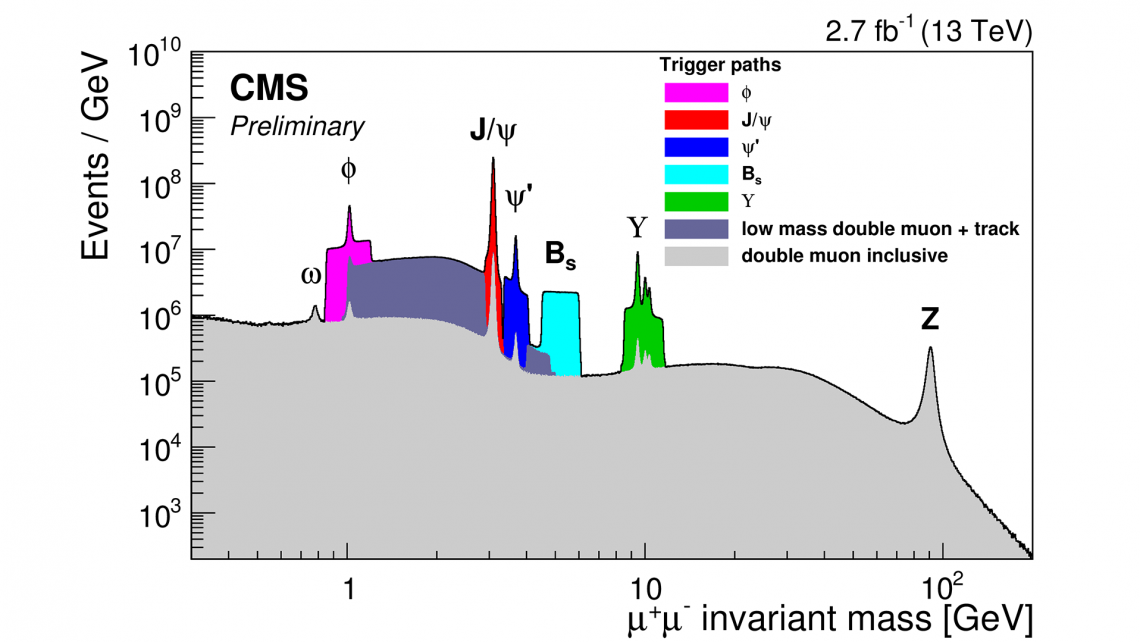
The first phase of collisions following the LHC restart earlier this year has provided CMS with a wealth of data at a new energy frontier of 13 TeV. This centre-of-mass collision energy, the highest ever achieved by a particle accelerator, is helping CMS explore uncharted domains of physics. Just a few days before CERN’s annual end-of-year closure, CMS and ATLAS presented comprehensive overviews of their latest results from analysis performed on data collected in 2015. Here we highlight a few of the key CMS results.
Seeing old friends
The LHC previously collided protons together with an energy of 7 TeV (2010, 2011) and 8 TeV (2012). Although the machine has delivered fewer collisions this year compared with 2012, the higher energy of the collisions has already provided CMS with an extended reach in searches for many new phenomena. Before exploring the unknown, CMS first observed the known, as beautifully illustrated in Images 1 and 2. Image 1 is the so-called “di-muon invariant mass spectrum” at 13 TeV, where the peaks in the mass distribution of muon pairs show previously discovered and well studied particles, from the ω (omega) meson to the Z boson [DP-2015-055]. The mysterious “ridge”, first observed by CMS in proton collisions in September 2010, makes its presence felt even at 13 TeV, as shown in Image 2 [FSQ-15-002]. Meanwhile, studies of the LHC’s most famous discovery, the Higgs boson observed in 2012, remain blinded at the time of the seminar.
Seeking the new
However, it was searches for new phenomena that filled CERN’s Main Auditorium to well beyond capacity. CMS has continued to search for semi-classical and quantum black holes. If they were to be produced in proton collisions, these black holes would very quickly transform into multiple hadron jets as they evaporate. Image 3 shows a collision event recorded by the CMS detector with 12 jets radiating from the collision point. In the absence of a signal over the expected background, CMS has set new lower limits of 8 TeV (quantum) and 8.7 TeV (semi-classical) for black-hole masses [EXO-15-007]. Hadron jets play a crucial role in searches for exotic particles, such as excited quarks (which would demonstrate that quarks are not elementary particles but composite ones) or heavier cousins of the W boson. These new particles would show their presence by transforming into two particle jets each; a characteristic high-mass di-jet event is shown in Image 4. In performing these searches, CMS looks for bumps in the mass distribution of the di-jet system and, seeing no significant excess over the background, has set new limits on the masses of many of these hypothetical particles [EXO-15-001]. CMS also looked for the presence of heavy particles such as a Z′ (Z-prime) boson in the di-lepton spectrum, where the unstable particles would transform into pairs of electrons or pairs of muons (a di-muon event from this search is shown in Image 5). While CMS observed high-mass events in both the di-electron and di-muon spectra, the data are so far compatible with the Standard Model and do not show any evidence for new physics [EXO-15-005]. Finally, CMS observed a slight excess in the di-photon channel (an event from this channel is shown in Image 6) at a mass of around 760 GeV [EXO-15-004]. Slight fluctuations like this excess come and go, and it is important to remember that we’re still far from claiming a new discovery. More data, which CMS will collect in 2016 and beyond, are needed to shine light on the nature of the excess. In total, CMS presented 33 results at the year-ending seminar, capping off an excellent period of commissioning, data taking and analysis in the first phase of the LHC’s Run 2.
- Log in to post comments

